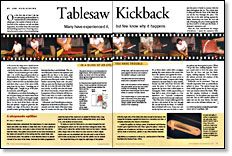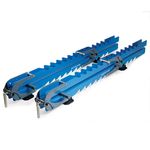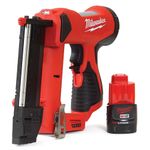Preventing Tablesaw Kickback
Many have experienced it, but few know why it happens
Synopsis: Before he lets students near a tablesaw, Lon Schleining shows them how dangerous kickback can be. A split-second series of photos shows Schleining’s demonstration. He explains how letting a piece rotate away from the rip fence results in kickback, and how other cuts are prone to it, too — a square piece being trimmed, such as drawer bottoms, or other small parts. With a splitter and blade guard in place, it’s much harder to lose control of your workpiece. Kelly Mehler’s accompanying article on building a shopmade splitter will help you avoid kickback.
On the first day of class I ask my woodworking students if they’ve had a kickback on the tablesaw. I always get a fair number of hands in the air, but few of the students can tell me what happened. And often those who have had the unsettling experience of carving a nice, deep furrow in a piece of wood and having it fly across the shop don’t usually know what caused it. It all happens so fast that it’s over by the time they realize it’s occurred.
Before I let my students get near a tablesaw, I do a little dog-and-pony show to demonstrate the dangers of kickback. Using styrofoam to represent a piece of plywood, I show how the cut should be made and then what occurs if the piece drifts away from the rip fence. Crouching out of the flight path, I simply let go of the piece for a second, and off it goes.
A kickback occurs when the leading corner of a piece being cut rotates away from the rip fence. The piece then gets caught up between the back of the blade and the fence. As the back of the blade—the part that cuts upward—begins to gnaw into the freshly cut edge of the piece, the piece quickly rotates, getting caught diagonally between the fence and the blade. The corner of the piece closest to the operator and against the rip fence is the pivot point around which a radius cut is made. The piece then acts like a pole-vaulter. Rotating further and moving faster now, the piece rides up and over the blade and is hurtled into the air to the left side of the blade. If you’re lucky, it will fly over your left shoulder. If you’re not lucky, a board with a few horsepower of force behind it will hit you. This is also why it is such a bad idea to stand to the left of the operator and watch him work.
Afterward, you’ll usually spot a crescent shaped cut on the bottom of the piece. This crescent cut is the result of the piece rotating as it crosses over the top of the blade.
From Fine Woodworking #139
For the full article, download the PDF below:
Fine Woodworking Recommended Products

Rockler Deluxe Panel Clamp

Milwaukee M12 23-Gauge Cordless Pin Nailer

Festool DF 500 Q-Set Domino Joiner





















Log in or create an account to post a comment.
Sign up Log in